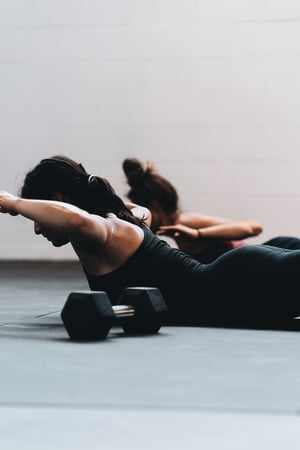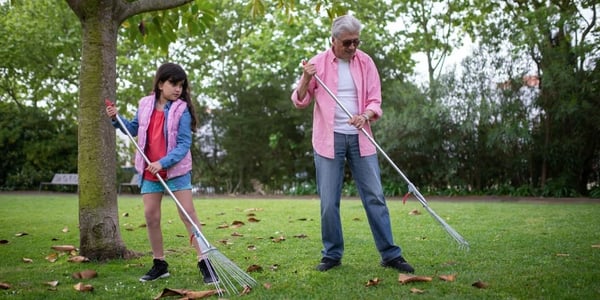According to the National Council on Aging (NCOA), every 1 in 4 people above 65 falls each year. An...
Pilates: What Are the Benefits for Older Adults?
Pilates, named after the creator, Joseph Pilates, is an exercise routine that focuses on creating an overall balance in the body. It comprises a set of exercises that focus on several fundamentals, including precision and balance. Pilates is known to increase core strength, flexibility, balance, and posture in the body. The exercise uses the body itself, and there is no specialized equipment necessary - though some routines may include the use of some props.
Today, Pilates is popular across the world because it is effective at improving flexibility, strength (especially core strength), breathing, posture, and overall physical fitness. Over the years, many people have found Pilates helpful, including some of the top Hollywood stars, making it even more popular.
 Pilates can be taken up at any age by anyone. The exercise routine is gentle. Pilates does not involve strenuous weight exercises or too much exertion. This makes it perfect for people who are looking for a calm way to get a healthy body. In addition, the adaptability of the exercise is such that Pilates can be altered to suit different needs. There are Pilates programs for children, men, mothers, and of course, for older adults.
Pilates can be taken up at any age by anyone. The exercise routine is gentle. Pilates does not involve strenuous weight exercises or too much exertion. This makes it perfect for people who are looking for a calm way to get a healthy body. In addition, the adaptability of the exercise is such that Pilates can be altered to suit different needs. There are Pilates programs for children, men, mothers, and of course, for older adults.
For older adults, Pilates is wonderful. It does not have the impact on the body that other forms of exercise do. Many exercises can have a significant load and impact on the joints. Pilates is also good for those who have not exercised for a long time and now want to get back to working out.
The Pilates regime is gentle and focuses on overall wellness rather than just brute muscle. Pilates focuses on strengthening the "core," which includes the deep abdominal muscles and the muscles closer to the spine. The majority of the exercises are low-impact, and some can be weight-bearing. They are performed in a reclined or seated position. As Pilates is gentle, and the activity focuses on the body's core, there are fewer risks of injury.
What Does the Routine Look Like?
 You will need a mat; a yoga mat will do. You will then prepare to execute a series of activities and movements to stabilize and develop your core. The exercises are often performed in a particular order, one after the other. Pilates exercises have their own names, like 'Swan' or 'Elephant'. The movement looks gentle, but Pilates focuses a great deal on accuracy and control. It is this accuracy and control that makes the exercise different from others. With Pilates, the technique with which you perform the movement is very important.
You will need a mat; a yoga mat will do. You will then prepare to execute a series of activities and movements to stabilize and develop your core. The exercises are often performed in a particular order, one after the other. Pilates exercises have their own names, like 'Swan' or 'Elephant'. The movement looks gentle, but Pilates focuses a great deal on accuracy and control. It is this accuracy and control that makes the exercise different from others. With Pilates, the technique with which you perform the movement is very important.
On average, a Pilates class or session lasts 45 minutes to an hour. However, you can start with shorter durations.
By doing Pilates, you'll get stronger, more sculpted muscles and also gain flexibility. Your posture will improve as well. Although Pilates focuses on the core, you can see the strength of the arms and legs increase as well. Pilates routines stimulate the core, but they rely on your arms and legs to control and deliver stress to the core.
The Benefits of Pilates
Pilates can be very beneficial, especially to older adults. Read through the ten benefits that Pilates can offer you.
-
Improve Core Strength
We have already mentioned that Pilates can help you improve your core strength. This is done through some precise and predetermined steps. The core is the central muscle set around the abdomen. The role of these muscles is to support and stabilize the body. A strong core means being better at maintaining the balance of your body when you are moving about. A weak core would cause problems such as back pain or hip pain. Think of the core as the hub of physical movement. Improving the core helps you properly balance the load that your body experiences when you move or carry something.
-
Better Posture
Pilates can help you achieve better posture. Improved posture is not only for looking good on the outside. Poor posture is linked to many other discomforts such as headaches, shoulder pain, and back pain. Pilates strengthens posterior muscles. These are the muscles on the back and shoulders of your body and helps you maintain a correct alignment.
-
Prevent Injuries
Many injuries are caused because your muscles are either too loose or too tight. Pilates helps you improve the dynamic strength of your muscles. As a result, your muscles will be able to respond to different activities better. Scientists have documented the benefits of Pilates against injuries.
-
Increase Energy
Pilates is not the same as aerobics, but it also focuses on breathing during the routine. Practicing Pilates can improve your lung capacity, and this will result in you feeling more energetic. Pilates has also been known to improve blood circulation and oxygen flow.
Want to know more about natural ways to improve your energy levels? Click here!
-
Improve Balance
Though balance is vital at any age, it is especially important when we get older. Balance is required for everyday tasks such as walking or other nonlinear motions, like reaching up and twisting. Pilates improves balance by not just strengthening the core but also by emphasizing alignment and whole-body movements.
Are you interested in improving your balance? Try these exercises!
-
Strengthen Immunity
We mentioned earlier that Pilates improves circulation. Scientists have attributed this cause to improved immunity, especially in older adults. Pilates and other exercises make your body more immune to infections. However, due to the gentle nature of the activity, it is the most appropriate for older adults.
-
Better Sex Life
Pilates is a way to strengthen and function your pelvic floor. A healthy pelvic floor is linked to enhanced sexual satisfaction. Pilates can enhance the value of your private moments. It improves endurance, strength, flexibility, and mobility, all of which can improve your sex life. In addition, Pilates allows you to stay in various sexual positions for more extended periods of time.
-
Enhance Cognitive Functions
Pilates can improve your cognitive functions. Cognitive functions are mental processes that allow us to carry out any task. This benefit is linked to new neuron development, blood flow to the brain, increased neurotransmitters, and longevity of neurons responsible for learning, memory, and executive thinking.
-
Lower Stress
Pilates movements are to be performed precisely and accurately. It also focuses on breathing properly during the routine. Focusing on breathing is also helpful in reducing stress. Conscious breathing is a way to down-regulate the nervous system.
-
Improve Emotional Wellbeing
Exercise, in general, is good for your mental health as well. Pilates can also contribute to your emotional well-being. Scientists have found a psychological benefit of doing Pilates. Engaging in any regular routine workout plan improves motivation. As a result, you will be better motivated to improve other aspects of your health and wellness. In addition, Pilates can have mood-boosting benefits, including experiencing a reduction in anxiety, fatigue, and depressive symptoms.
Let us know in the comments below - Have you tried Pilates? What do you like about it most?






